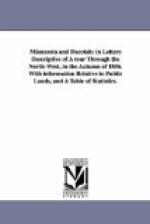It is obvious that, in municipal settlement, as well as agricultural, there must be space of time between the commencement and the consummation of occupation. There will be a moment, when the equitable right of the agricultural settler is fixed, although he have as yet done nothing more in the way of inhabiting or improving than to cut a tree or drive a stake into the earth. And it may be long before he improves each one of all his quarter quarter-sections. So, in principle, it is in the case of settlement for a town. We must deal with such things according to their nature. Towns do not spring into existence consummate and complete. Nor do they commence with eight houses, systematically distributed, each in the centre of a forty-acre lot. And in the case of a town settlement of three hundred and twenty acres; as well as that of a farm site of one hundred and sixty acres, all which can be lawfully requisite to communicate to the occupants the right of preemption to the block of land, including every one of its quarter quarter-sections,— is improvement, or indication of the improvement of the entire block,— acts of possession or use regarding it, consonant with the nature of the thing. That, in a farm, will be the erection of a house and outhouses, cultivation, and use of pasturage or woodland: in a town, it will be erecting houses or shops, platting out the land, grading or opening streets, and the like signs and marks of occupation or special destination.
The same considerations lead to the conclusion that it would not be just to confine the proofs of occupation to facts existing at its very incipiency. The inchoate or equitable right, as against all others, begins from the beginning of the occupation: the ultimate sufficiency of that occupation is to be determined in part by subsequent facts, which consummate the occupation, and also demonstrate its bona fides. If it were otherwise, there would be an end of all the advantage expressly given by the statute to priority of occupation. Take the case of agricultural preemptions for example. A settler enters in good faith upon a quarter-section for preemption; his entry, at first, attaches physically to no more than the rood of land on which he is commencing to construct a habitation. Is that entry confined in effect to a single quarter quarter? Can other settlers, the next day, enter upon all the adjoining quarter quarters, and thus limit the first settler to the single quarter quarter on which his dwelling is commenced? Is all proof of occupation in his case, when he comes to prove up his title, to be confined to acts anterior to the date of conflict? Clearly not. The inchoate title of the first occupant ripens into a complete one by the series of acts on his part subsequent to the original occupation.




